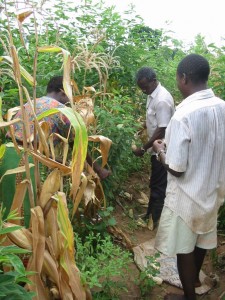Multipurpose Legumes for Soil Rehabilitation

Pigeonpea stand at time of maize harvest
Description
In Malawi there is a growing body of evidence that soil organic matter rehabilitation is urgently needed – yet widely promoted approaches such as agroforestry, conservation agriculture and livestock integration all face major challenges. A farmer-approved approach, widely shown to be feasible for adoption, is expanded production of pigeonpeas (Cajanus cajan) and other multipurpose legumes (e.g. Doubled Up Legumes). These shrubby or viney plants are unique because they can provide food and other agricultural products while at the same time regenerating soil carbon, fixing nitrogen, and solubilizing phosphorus for improved soil productivity.
Technologies that support manure production, such as residue mulch systems, agroforestry, and intensified livestock systems, are promoted to build long-term soil productivity in Malawi. Additionally, knowledge of soil erosion control focusing on management practices such as planting on the contour and building bunds to control water flow is urgently needed. Efficacy of these management practices will require widespread education efforts and our lab group is invested in collaborating with Malawi government extension in these areas. We are particularly interested in approaching these through innovative education practices such as farmer field schools, innovation platforms and participatory co-learning in support of farmer experimentation.
At the same time, there are significant challenges to these approaches, such as low livestock numbers in Malawi’s rural communities. Furthermore, there has been very little evidence that farmers are able or interested in investing in agroforestry systems. High labor requirements and/or limited returns may be major impediments. Conservation agriculture in various forms has also been promoted in Malawi, but there are barriers to its uptake and weed management in these forms of agriculture remains one of the major constraints.
Another approach to rehabilitating soils has risen to the fore in recent years. On-farm research initiated in Malawi in the mid 1990s has consistently indicated farmer preference for multipurpose pigeonpea mixtures rather than agroforestry or green manure systems (Chikowo, et al., 2014; Kanyama-Phiri et al., 1998; Snapp et al., 1998). The risk of household food insecurity has been shown to be minimized through adoption of pigeonpea-based organic matter technologies with more mixed results from agroforestry technologies (Sirrine et al., 2010). One of the most promising multi-purpose legume systems for Malawi mid-altitude zones involves using pigeonpea either grown in mixtures with maize or as a doubled up legume system (pigeonpea and an understory of soybean or groundnut), then rotated with maize. Snapp et al. (2010; 2014) found evidence of superior performance from these systems in country-wide trials.
However, there has not been sustained effort to investigate the potential for soil organic matter rehabilitation through diversification with these plant types. High variability of soil organic carbon and management effects are difficult to detect on-farm (Snapp et al., 2010a). Yet, results from on-farm trials in Malawi indicate aboveground residues produced by leguminous shrubs and vines such as pigeon pea, mucuna, climbing beans and tephrosia are nitrogen-enriched and of mixed quality biochemistry, in the range of 3 to 5 MG biomass per ha (Table 1, Snapp et al., 1998; 2010a). Root biomass measurements have recently been conducted for pigeon pea grown on over 40 fields in Central Malawi, where biomass ranged from 0.9 to 2.0 MG biomass per ha (Gwenambira, 2015). These levels of vegetative biomass and in particular the root organic material are expected to translate into improved soil organic C (Kong et al., 2005; Puget and Drinkwater, 2001).
In terms of maize yield improvements, the maize-pigeonpea intercrop system was the highest performer. It is also well suited to small land holdings and imperfect market conditions where farmers cannot sell legume grain with a reasonable expectation of obtaining sufficient profit or access to maize. Many farmers in the region use pigeonpea as a relish, or secondary food source. At the same time, the doubled up legume rotated with maize system, was especially promising in favorable growing seasons and produced as much maize yield as monoculture maize fertilized at twice the rate (Figure 1).
Two additional benefits from the multipurpose legumes may be climate change resilience and improved water use efficiency through hydraulic lift. Climate resilience gains are particularly marked when maize hybrids are grown with targeted fertilizer, in rotation with doubled up legume and mucuna rotations. This has been shown to not only improve maize fertilizer response by 50% or more, but also to dramatically enhance yield stability (Snapp et al., 2010). Competition for water from pigeonpea shrubby growth types with maize and other food crops may be minimized if pigeonpea is able to facilitate hydraulic lift of water to the surface. There is evidence from Zambia of this phenomena (Sekiya and Yano 2004) and the Snapp research group has recently initiated field experiments in Mali to test this hypothesis.
In summary, growing more biomass is one of the only ways to enhance soil C and N status under on-farm conditions in the sub-humid tropics of East Africa. Livestock integration, conservation practices, organic farming and integrated nutrient management all require a foundation of biomass, particularly high quality legume biomass. Indeterminant, shrubby forms of legumes such as pigeonpea can provide substantial amounts of biomass over 8 to 24 months, and many such species fix copious amounts of N over this time period. In contrast, annual food legumes are grown for about 4 months with about half the plant biomass removed at harvest index, which minimizes residue biomass to insignificant amounts. The biomass potential of multipurpose legumes grown in the often marginal soils of East Africa agricultural lands is understudied and should be a priority.
Principles:
- Soil quality rehabilitation, in particular building soil organic matter and improved nutrient use efficiency
- Improved agricultural biodiversity
- Biological nitrogen fixation
- Possibility for herbicide reduction
- Offers secondary benefits from legumes (e.g. food, fodder or fuelwood)
- Improved farm sustainability
- May reduce yield variability risk
- May offer climate change resiliency
Debates:
- Growing large amount of vegetation may put demands on water use and the ability for the water availability to recharge in time for the next crop
- A pigeonpea mixed system may be overly competitive for nutrients and other resources, or the growth traits may be sufficiently complementary. There is a complexity here and the answer is expected to vary with agroecology and socio-economic conditions.
- Scalability of multipurpose legumes such as pigeonpea and climbing bean. That is, do specific household characteristics predict interest and adoption of multipurpose legumes? Under which market conditions, agroecozones, soil types and climate do different pigeonpea varieties, climbing bean or doubled up legume technologies perform well?
- Marginal loss of maize yields though this is expected to vary strongly based on environmental factors such as water availability and climate. The benefit of additional grain legume yield may more than make up for reduced maize yield, and further research is underway.
- Complex system with many adjustments and adaptations undertaken by farmers depending on priorities and local conditions, so what is optimal under one environment may require redesign under another, showing the value of farmer participatory research approaches (link).
Links:
FAO profile of our research on legumes and land productivity in Malawi (pdf)
Learning Lab Resources:
Beedy, T.L., S.S. Snapp, F.K. Akinnifesi and G.W. Sileshi. 2010. Long-term impact of Gliricidia sepium intercropping and inorganic fertilizer on soil organic matter fractions in maize-based cropping systems. Agric. Ecosystems and Environment 138:139-146.
Chikowo, R., Zingore S, Nyamangara J. Bekunda M, Messina J, Snapp S.S. 2014. Approaches to reinforce crop productivity under water- limited conditions in sub-humid environments in Africa. In: Sustainable Intensification to Advance Food Security and Enhance Climate Resilience in Africa (Lal R, Mwase D, Hansen F, Eds). Springer. 235-253pp.
Gwenambira, C. (2015). Below- and Aboveground Pigeonpea Productivity in on-Farm Sole and Intercrop Systems in Central Malawi. Michigan State University. Ann Arbor: ProQuest. Web.
Kanyama-Phiri, G.Y., S.S. Snapp and S. Minae. 1998 Partnership with Malawian farmers to develop organic matter technologies. Outlook on Agriculture 27:167-175.
Mhango, W. S.S. Snapp and G. Y. Kanyama-Phiri. 2013. Opportunities and constraints to legume diversification for sustainable cereal production on African smallholder farms. Regenerative Agriculture and Food Systems 28:234-244.
Sirrine, D., C. Shennan, S.S. Snapp, G. Kanyama-Phiri, and B. Kamanga. 2010. Agroforestry, risk and vulnerability in Southern Malawi: improving recommendations resulting from on-farm research. International Journal of Agricultural Sustainability 8:290-304.
Snapp, S.S. M.J. Blackie, R.A. Gilbert, R. Bezner-Kerr, and G.Y. Kanyama-Phiri. 2010. Biodiversity can support a greener revolution in Africa. PNAS 107: 20840-20845.
Snapp, S.S., T.S. Jayne, W. Mhango, T. Benson and J. Ricker-Gilbert. 2014. Maize yield response to nitrogen in Malawi’s smallholder production systems. Working Paper 9. Malawi Strategy Support Program. IFPRI.
Snapp, S.S., P.L. Mafongoya and S. Waddington. 1998. Organic matter technologies to improve nutrient cycling in smallholder cropping systems of Southern Africa. Agriculture, Ecosystems and Environment 71:187-202.
Extended Bibliography and Works Cited:
Kong, A.Y.Y., J. Six, D.C. Bryant, R.F. Denison, and C. van Kessel. 2005. The relationship between carbon input, aggregation and soil organic carbon stabilization in sustainable cropping systems. Soil Sci. Soc. Am. J. 69:1078-1085.
Powlson, D.S., C.M. Stirling, M.L. Jat, B.G. Gerard, C.A. Palm, P.A. Sanchez and K.G. Cassman. 2014. Limited potential of no-till agriculture for climate change mitigation. Nature Climate Change. 4:678-683. DOI: 10.1038/NCLIMATE2292
Puget, P. and L.E. Drinkwater. 2001. Short-term dynamics of root- and shoot-derived carbon from a leguminous green manure. Soil Sci. Soc. Am. J. 65:771-779.
Sekiya, N. and K. Yano. 2004. Do pigeon pea and sesbania supply groundwater to intercropped maize through hydraulic lift? —Hydrogen stable isotope investigation of xylem waters. Field Crops Research 86: 167–173.
Challenges Addressed: Poverty & food insecurity; Soil quality and low productivity; Climate change; Poor access to organic and inorganic inputs; Contested agronomy- moving beyond silver bullets; Carbon, nitrogen and phosphorus as drivers
Tags: Agrobiodiversity; Agronomy; Climate Change; Extension; Sociology; Soil Science; and Sustainability Science

Table 1. Legume life-forms and example species grown in Malawi agriculture and the value of associated products. Adapted from Mhango et al., 2013.

Figure 1. Adaptability analysis of maize yield performance of maize grown with multipurpose legume systems compared to monoculture maize at different N input rates, relative to average maize yield performance at a site over time. Results reported for two sites, high potential Linthipe and low potential Golomoti, both in Central Malawi. Model simulation carried out using APSIM for over a decade of weather files from the two sites (Smith et al., unpublished data, 2015).



